As an Amazon Associate, I earn from qualifying purchases.
An easy step-by-step tutorial on Canning Cherries. This recipe for how to preserve cherries is perfect for beginners and experienced canners alike. Instructions include low-sugar and no-sugar options.
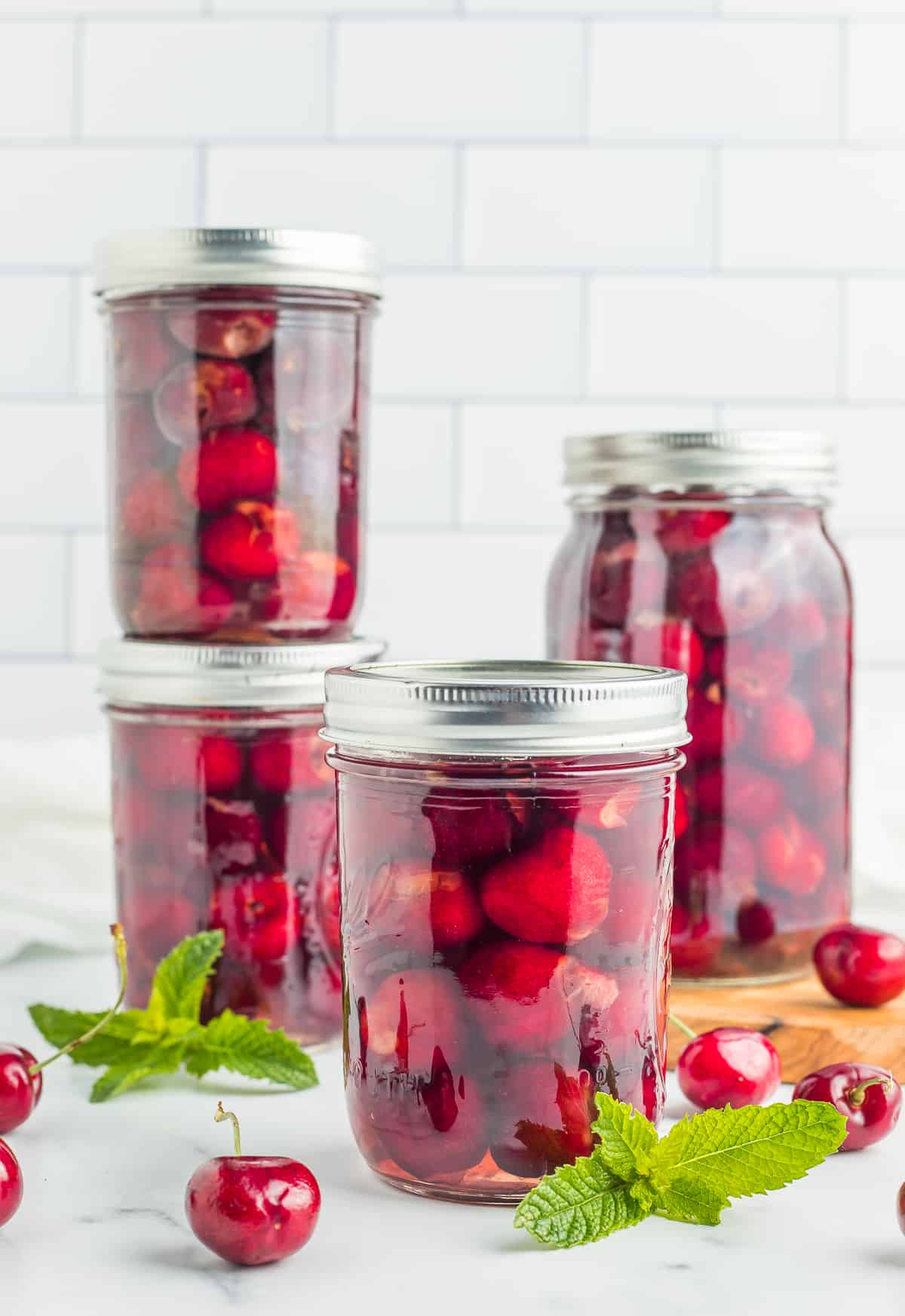
I have great news for you! Cherries are one of the easiest fruits to can. There is no peeling or fussy prep work required. Heck, you can even can them with pits if you want to!
Even better, I’m going to teach you how to make canned cherries in a light syrup, so you can actually taste the fruit and not just sugar. Need no-added-sugar options? We’ve got them!
And if you decided that canning cherries is just not for you, check out our tutorial on how to freeze cherries.
After trying this recipe, can the other star of summer produce – peaches! Check out our tutorial on canning peaches for a step-by-step guide on preserving that tasty fruit.
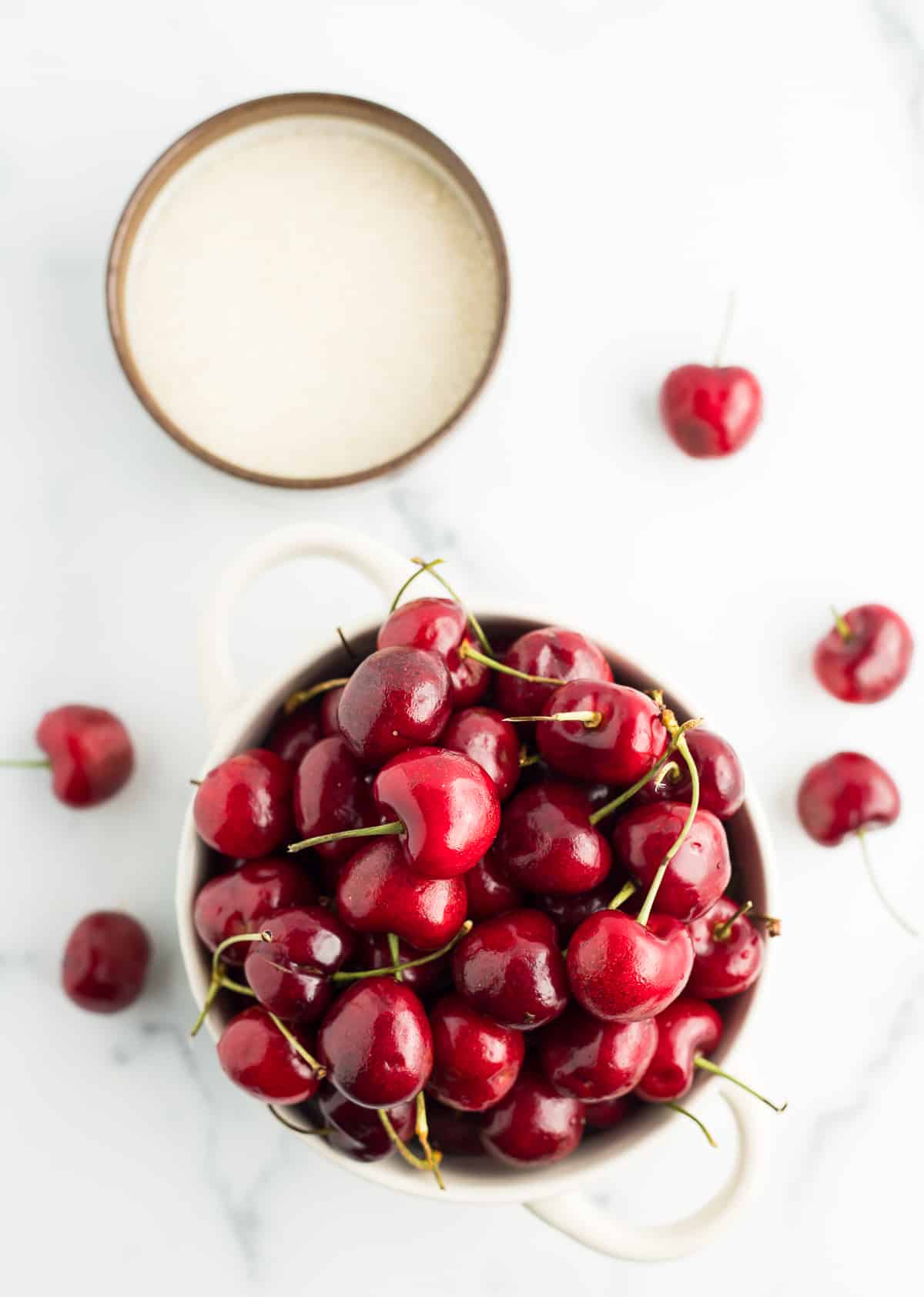
HOW TO CAN Cherries
*I’ll walk you through it here with some photos and tips, and you’ll also find a printable recipe card at the bottom of the post with exact measurements, etc. You can also click “jump to recipe” to skip down.
CANNING PREP
Prepare your water bath canner by filling it with water. You need to have enough water to cover the jars by 1 inch once the water is boiling.
Set the canner on the stove. Turn the burner to high. Once it reaches a boil, reduce it to a simmer. You want to keep the water hot so that everything is ready when the fruit is.
Wash and clean your jars. You’ll want to keep them warm to avoid having them crack when placed in the canner. You can fill them with hot water, or place them on a tray in the oven at 170˚F.
Wash your lids and set them aside in a clean place. You no longer need to simmer lids in water to keep them sterile. Woot!
Wash the cherries. Remove the stem and decide if you’d like to can them pitted or can them with the pit still in the cherry. I always pit them prior to canning, but to each their own.
If you’d like to pit before canning, set up a bowl of cool water with 1/4 cup of lemon juice. As you pit them, place the cherries in the lemon water until you’re ready to can them. This keeps them from browning.
Pro tip: I like to pit cherries on my front porch while wearing all-black clothes. It definitely makes kitchen AND laundry clean-up a lot easier.
If you’re choosing to not pit them, you’ll need to prick the skin with a clean needle, skewer, or other fine-point sharp device to prevent the skin from splitting during the canning process.
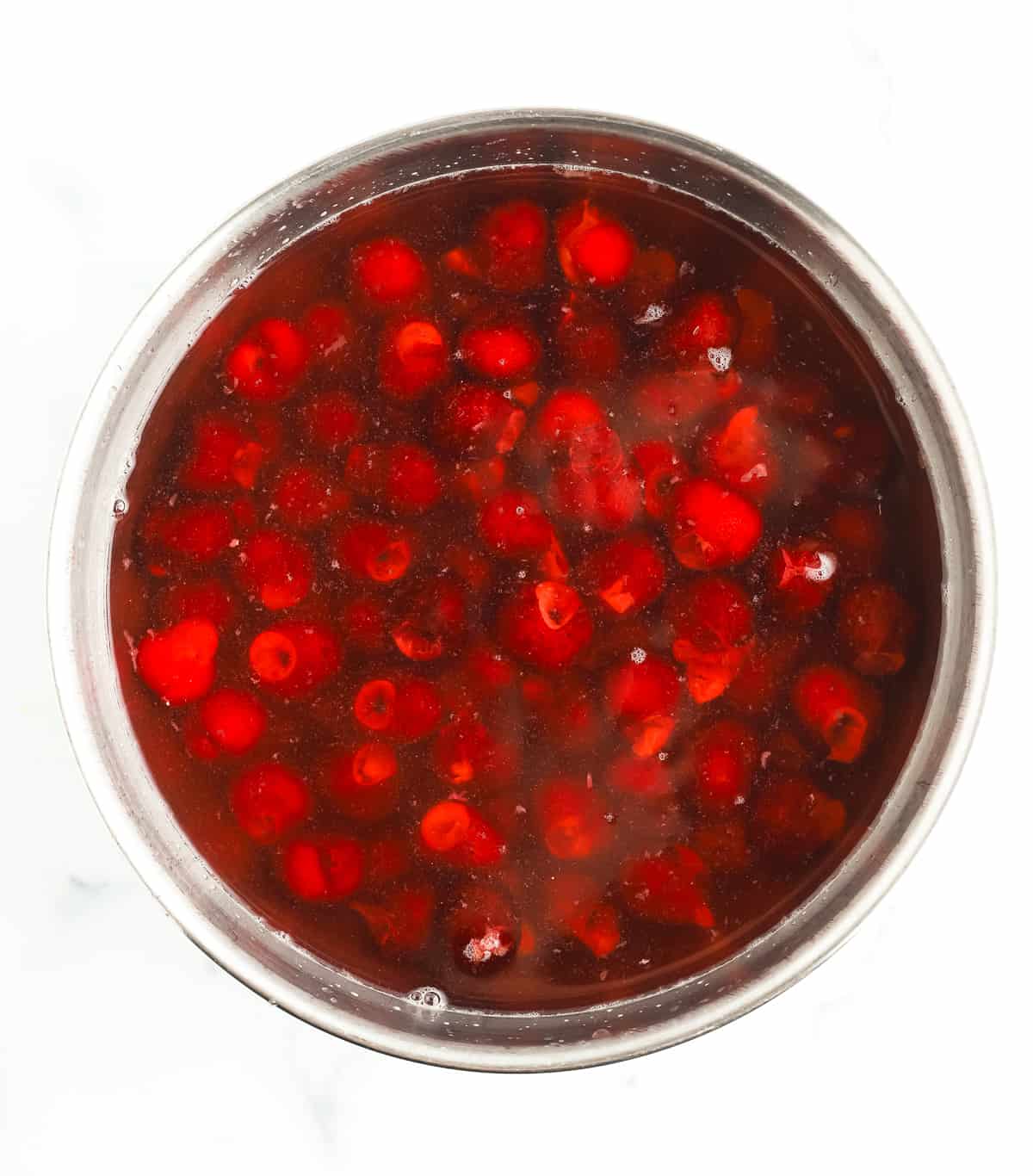
SYRUPS FOR CANNING Cherries
If you prefer a no-sugar option, cherries can be canned using only water. But if you plan to can your cherries with sweetener, you can use sugar, honey, or fruit juice (apple or white grape). You’ll also want to decide how sweet you want the syrup to be, especially if you’re canning sour cherries.
See the cheatsheet below as a guideline for making syrup:
Syrups for Canning
| Syrups for Canning | ||||
| Type of Syrup | Sweetener | Amount of Sweetener | Water | Yield |
| Very light | Sugar | 1 cup | 6 cups | 5 3/4 cups |
| Light | Sugar | 2 1/4 cups | 5 1/4 cups | 6 1/2 cups |
| Medium | Sugar | 3 1/4 cups | 5 cups | 7 cups |
| Heavy | Sugar | 4 cups | 5 cups | 7 cups |
| Honey | Honey | 1 cup | 4 cups | 4 1/4 cups |
| Juice | Apple or white juice concentrate | 1 1/2 cups | 4 1/2 cups | 6 cups |
| *Source: National Center For Home Food Preservation | ||||
Pro tip: if you plan to process multiple batches of cherries in a day, make the syrup and transfer it to a slower cooker set to “high”. This will keep the syrup hot while freeing up space on your stove.
Raw Packing Cherries
Raw packing simply means placing the fruit in the jars without pre-cooking them, filling the jars with hot syrup (or water), and processing them in the canner.
Raw packing is generally faster than then a hot packing process, but there are some drawbacks. No matter how well you pack the jars, the density of the fruit will change during their time in the canner.
This often leads to something called “fruit float” in which the fruit will float to the top of the jar, leaving all syrup on the bottom. You’ll find this when you’re canning pears, canning apricots, and canning whole tomatoes as well. There is nothing wrong with fruit float as long as your jars are still sealed.
To raw pack the cherries, using a canning funnel and a ladle, fill each jar with drained cherries. Tap and shake the jar down, and add 1/2 cup of hot syrup/water.
Continue to add cherries and syrup until the jar is full and there is 1/2 inch of headspace at the top of the jar. Headspace is the distance between the top of the food and the top of the jar. You may need to use a spoon to gently smoosh down the cherries a bit.
Hot Packing Cherries
Hot packing involves cooking the cherries briefly in hot syrup before packing the fruit into jars for canning. In the case of hot packing cherries, you can actually create the syrup as you heat the cherries.
Unlike when canning pears or canning peaches, I prefer to hot pack cherries, simply because it uses one less pot. You can create the syrup and heat the cherries together in one step.
Place the drained cherries in a large heavy-bottomed saucepan (I used my enameled Dutch Oven), and add the water and sugar. Use the syrup chart above to decide how much sweetener you’re going to add. You’ll see I simply sprinkled the sugar on top of the cherries.
Heat the cherries, water, and sweetener, stirring gently until the cherries reach a low boil and any sugar is dissolved. Reduce the heat to a simmer.
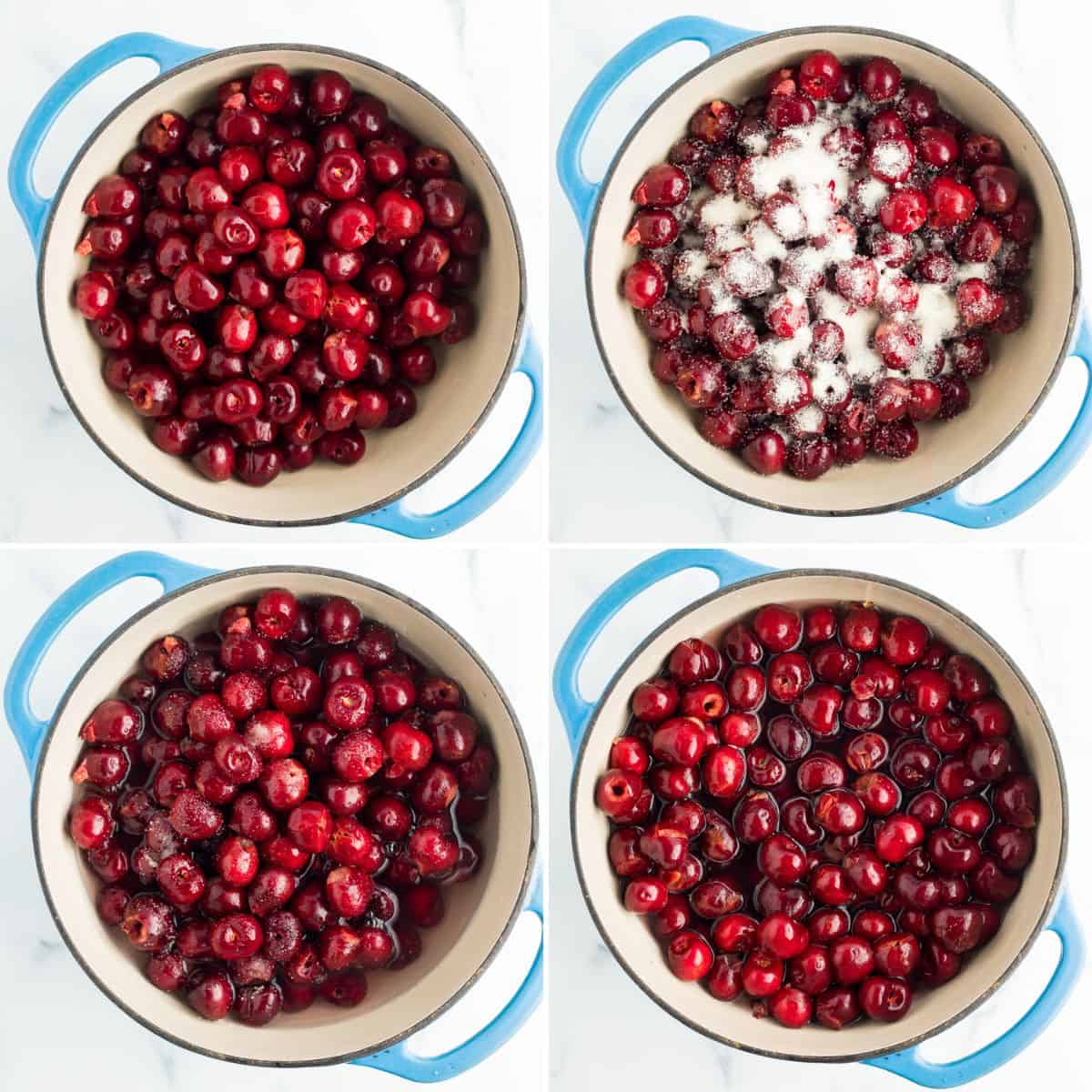
Using a canning funnel, ladle the cherries and syrup into your jars until the jars are full and there is 1/2 inch of headspace. Using a long utensil (I prefer a plastic chopstick), remove all the air bubbles from the jar.
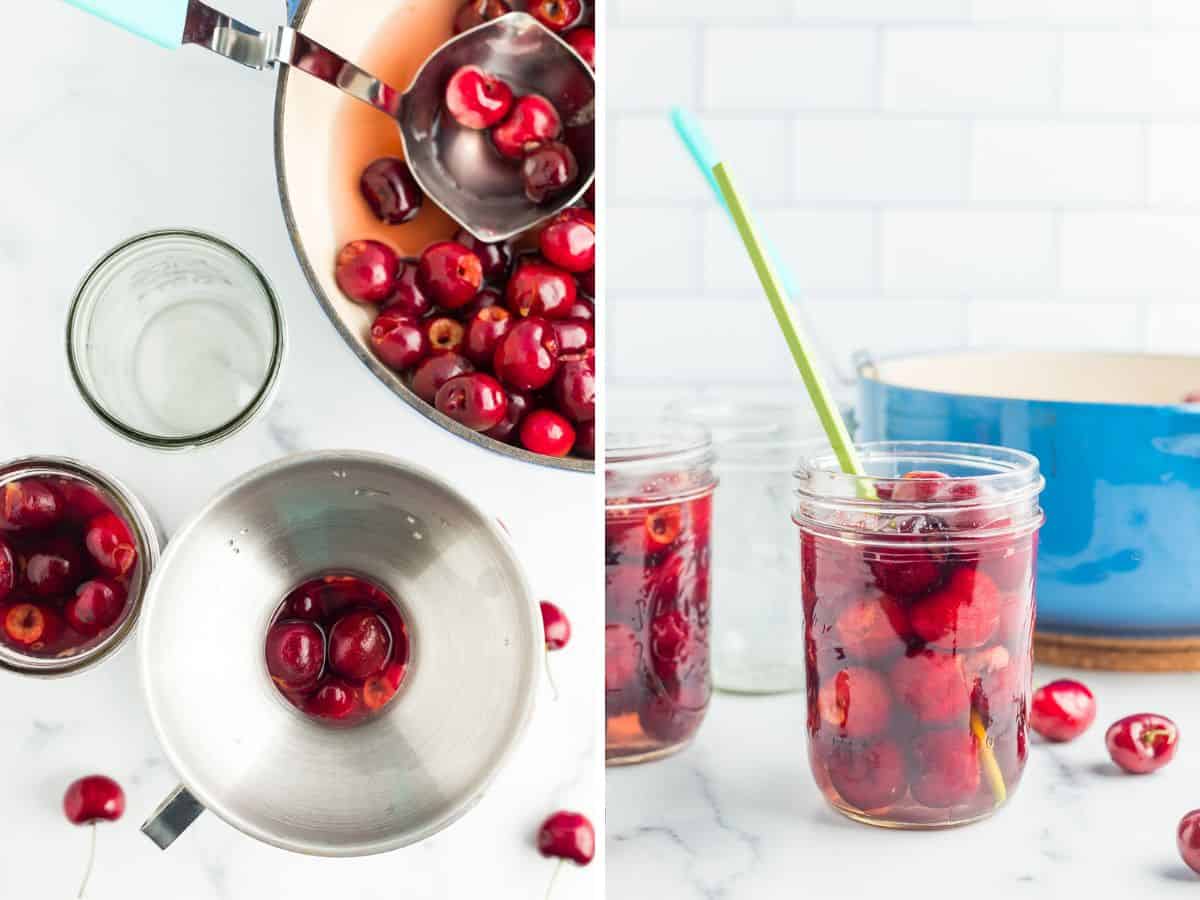
Clean the rim of the jar very well with a hot damp rag. Place a clean lid on the jar. Add a ring, and tighten to fingertip tight.
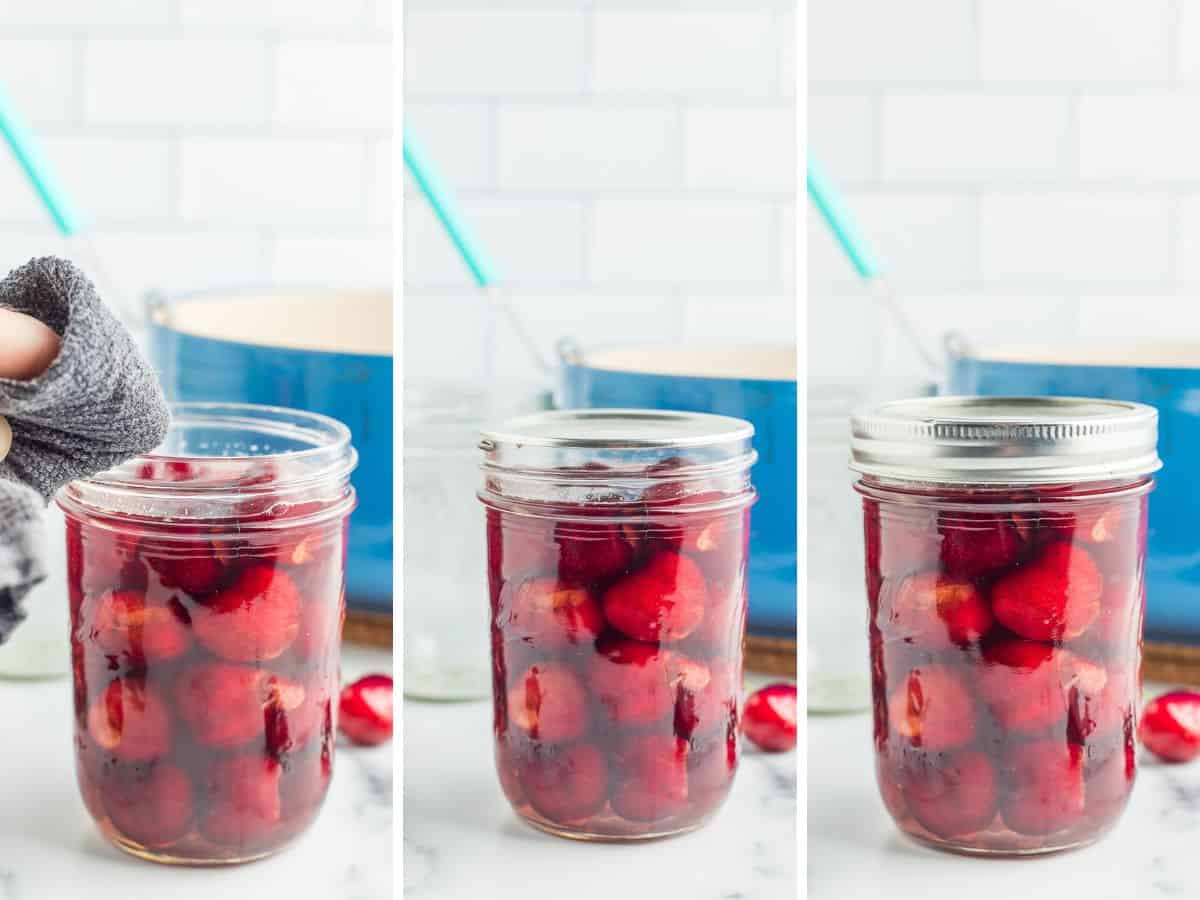
Using canning tongs, carefully place your jars in the canner. Put the lid on, and set your timer. Pro tip: If you don’t have enough jars to fill the canner, consider Canning Water in a few jars to stock your emergency drinking water supplies.
PROCESSING TIME FOR Cherries
Processing Time for Sweet or Sour Cherries
| Processing Time for Sweet or Sour Cherries | |||||
| Process Times at Altitudes of: | |||||
| Style of Pack | Jar Size | 0-1,000 ft | 1,001-3,000 ft | 3,001-6,000 ft | Aove 6,000 ft |
| Hot | Pints | 15 min | 20 min | 20 min | 25 min |
| Quarts | 20 min | 25 min | 30 min | 35 min | |
| Raw | Pints or Quarts | 25 min | 30 min | 35 min | 40 min |
| *Source: National Center For Home Food Preservation | |||||
Once the jars have been processed for the appropriate amount of time, remove the canner from the burner, wearing oven mitts carefully take off the lid of the canner, and allow it to sit for 5 minutes. Pro tip: I tend to just slide the canner into the middle of my stove, as it weighs a ton.
Carefully remove the jars with canning tongs, and place them on a thick towel in a place where they can be undisturbed for 12 hours.
The lids will likely start to pop within 20-30 minutes of being removed from the water. That popping sound is music to your ears, as it tells you that everything has been sealed. It’s a reward for all your work!
After the jars have rested for about 12 hours, press down in the middle of each lid. If it “gives” at all, the jar didn’t seal. Either enjoy it that day, put it in the fridge, or reprocess it.
Pressure Canning Cherries
If you prefer to pressure can your cherries, follow the prep and packing process above and the canning process below.
Add 3 quarts of water to your pressure canner and put it on a burner set to high. Make sure there is a canning rack in the bottom of the canner.
Using canning tongs, gently place the jars in the canner. Lock the lid. Soon, steam will start coming through the vent pipe (I call it the steam chimney).
Allow the steam to pass through for about 10 minutes. Then put the pressure regulator (I call it the chimney cap) on top. (see the 4 photo grid below for a visual of this process step by step)
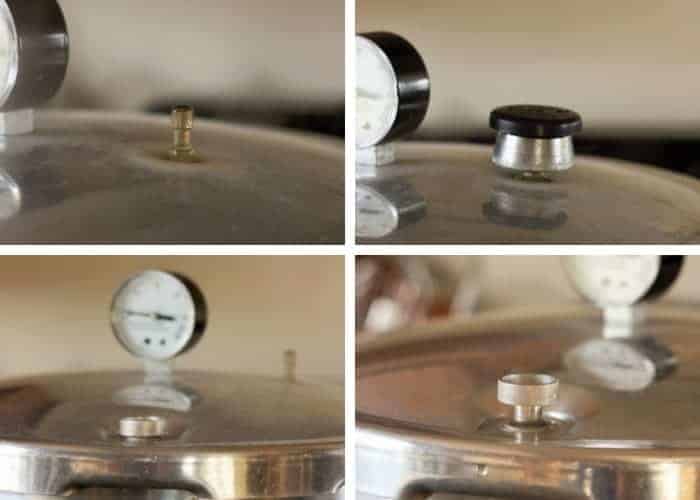
Pretty soon, the air vent will pop up. That is a sign that you’re starting to build pressure inside the canner (get excited. This is happening!). Processing times will vary based on altitude. See the charts below.
Pressure Canning Sweet or Sour Cherries in a Dial-Gauge Pressure Canner
| Canner Pressure (PSI) at Altitudes of | ||||||
| Style of Pack | Jar Size | Processing Time | 0-2,000 ft | 2,001-4,000 ft | 4,001-6,000 ft | 6,001-8,000 ft |
| Hot | Pints | 8 min | 6 lbs | 7 lbs | 8 lbs | 9 lbs |
| Quarts | 10 min | 6 lbs | 7 lbs | 8 lbs | 9 lbs | |
| Raw | Pints or Quarts | 10 min | 6 lbs | 7 lbs | 8 lbs | 9 lbs |
| *Source: National Center For Home Food Preservation | ||||||
Processing Time for Sweet or Sour Cherries in a Weighted-Gauge Pressure Canner
| Canner Pressure (PSI) at Altitudes of: | ||||
| Style of Pack | Jar Size | Processing Time | 0-1,000 ft | Above 1,001 ft |
| Hot | Pints | 8 min | 5 lb | 10 lb |
| Quarts | 10 min | 5 lb | 10 lb | |
| Raw | Pints or Quarts | 10 min | 5 lb | 10 lb |
| *Source: National Center For Home Food Preservation | ||||
When the dial gauge reaches the appropriate PSI, reduce the burner temp to medium, and start your timer. The pressure must stay at the PSA or (a little bit) above for the duration of the cooking time. You’ll likely need to adjust the temp on the burner a few times depending on your stove.
When the time is up, remove the canner from the burner and allow it to sit until you hear a distinctive “click” of the air vent dropping. Remove the pressure regulator and carefully remove the lid of the canner (Pro tip: I always use oven mitts when I take the lid off because the steam is super hot).
Let the jars sit for 5 minutes in the canner with the canner lid off and then lift them out with canning tongs. Pro tip: allowing the jars to sit in the canner with the canner lid off can help reduce the siphoning of liquid in your jars.
Place hot jars on a towel where they can sit undisturbed for 12 hours.
After a few hours, to check for sealing, gently press down in the middle of the lid. If the lid has no give, it’s sealed. If you can press the lid in and it pops a bit, your jars are not sealed.
HOW MANY Cherries DO YOU NEED?
An average of 17 pounds is needed per canner load of 7 quarts; an average of 11 pounds is needed per canner load of 9 pints. A lug of cherries weighs 25 pounds and yields 8 to 12 quarts – an average of 2 & 1/2 pounds per quart. (source)
If you don’t have a large batch of cherries to can at once, you can process just a few jars if needed. It eventually does add up over the season!
WHAT IF MY JARS DON’T SEAL?
If you’ve correctly processed your fruit, and the lids still didn’t seal, you can reprocess them.
Double-check to make sure there are no:
- Chips in the rim of the jar
- Dried syrup or bits of cherries on the rim (anything between the rim and the lid may prevent a seal.
Best practices would involve using brand-new lids for reprocessing. Set aside the old lids to use for dry goods storage (related: Pantry Essentials for the Home Cook).
If the jars don’t seal on the second attempt, you likely have a bad batch of lids, or your canning process has a misstep. Email me and we’ll try to troubleshoot what is going on.
For unsealed jars, you can place them in the fridge. Eat the fruit within three weeks.
HELP! WHY ARE MY JARS LEAKING JUICE?
If you find that juice has leaked out after they have sealed, you have experienced a common canning issue called siphoning. It happens to the best of us!
Siphoning is typically caused by not allowing the jars to rest in the canner after they have finished processing. In the directions above, you’ll see that I recommend you remove the canner from the burner, remove the lid of the canner, and let it sit for 5 minutes.
This is important as it allows the jars time to rest before being allowed to cool on the counter. Doing this process will significantly cut down on siphoning.
IF YOU HAVE SIPHONING IN YOUR JARS, FOLLOW THESE STEPS:
- Check – are the lids still sealed?
- Look – have you lost less than half of the amount of liquid in the jar?
- Examine – does the fruit look fresh with bright colors?
If the answer to the above three steps is “yes!”, then they are safe to eat. If you lost quite a bit of syrup, the uncovered fruit will turn color more quickly. Plan to eat those jars first.
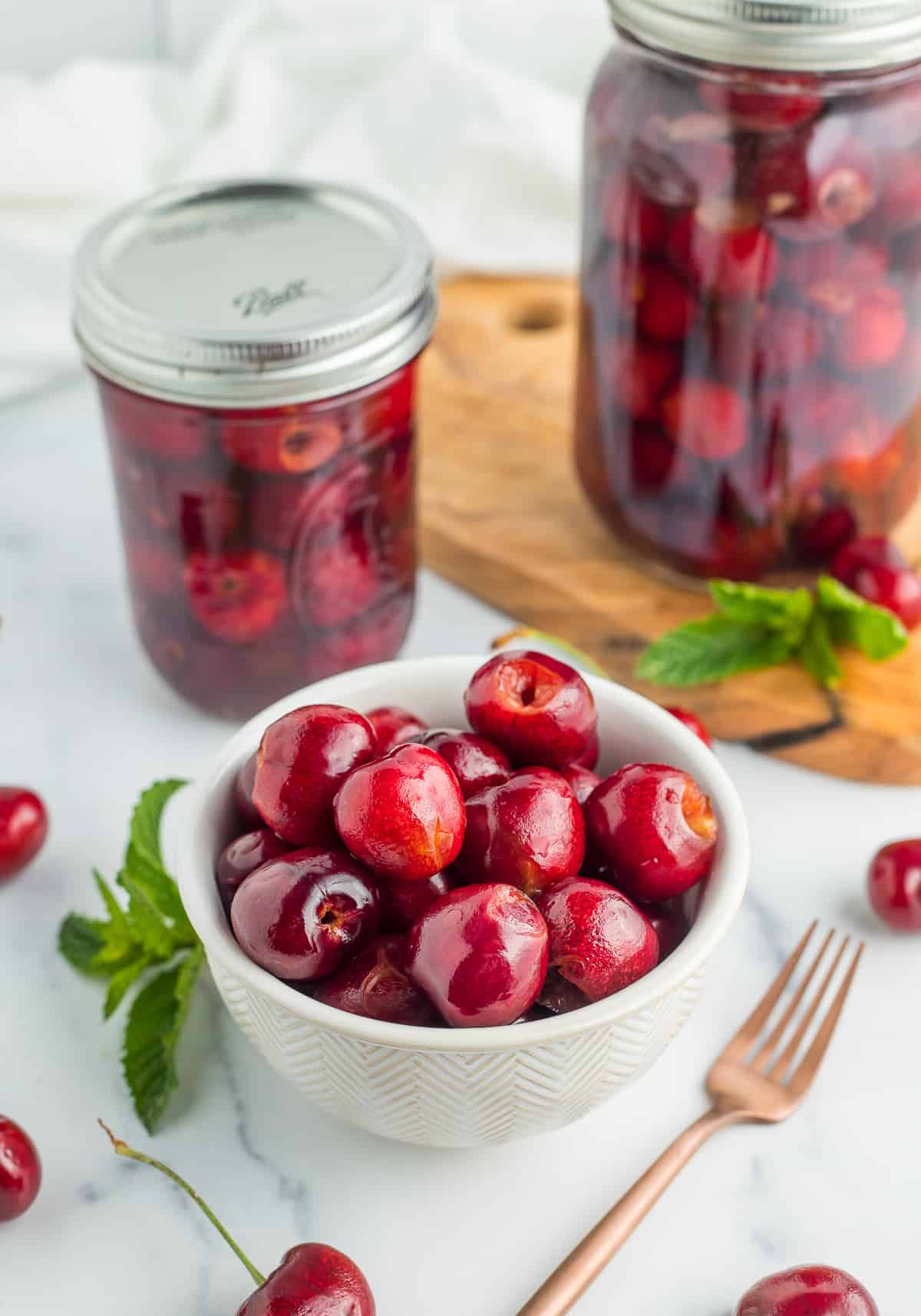
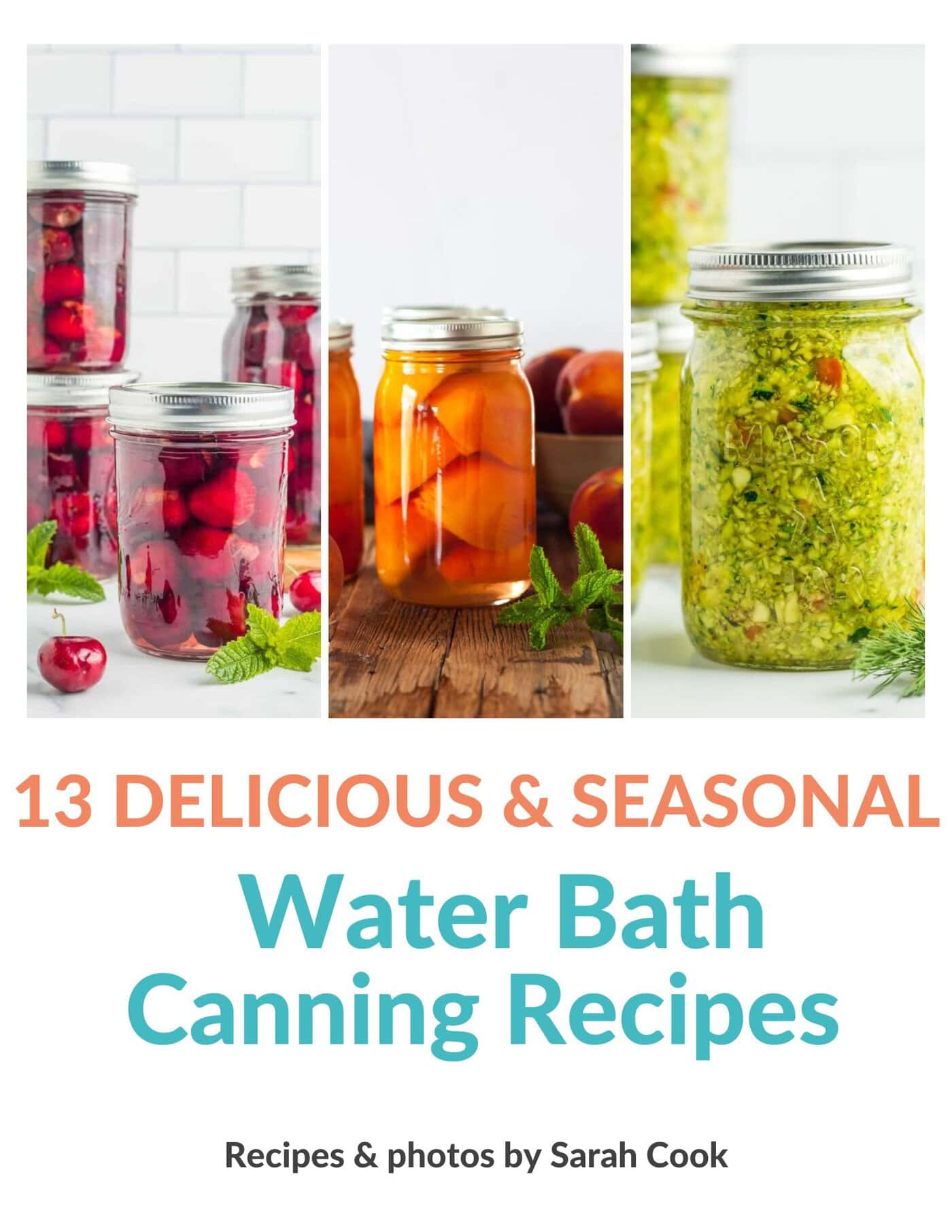
Get my Canning e-book!
It’s 51 pages of every helpful tip and trick you could want as a brand new canner, AND it includes 13 ad-free canning recipes that are designed to take you from novice to pro.
Canning Cherries
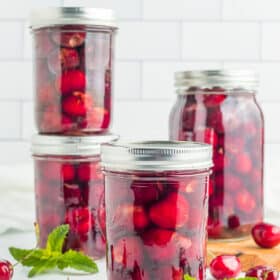
Equipment
- Cherry pitter
Ingredients
- 11 lbs cherries {sweet or sour}
- 1/4 cup lemon juice
- 6 cups water {+more for the canner}
- 1 1/2 cups sugar
Instructions
Canning Prep
- Prepare your water bath canner by filling it with water. You just need to have enough water to cover the jars by 1 inch once the water is boiling.
- Set the canner on the stove. Turn the burner to high. Once it reaches a boil, reduce it to a simmer. You want to keep the water hot so that everything is ready when the cherries are.
- Combine a few cups of cool water with 1/4 cup of lemon juice or 1 tbsp of citric acid.1/4 cup lemon juice
- Wash and sanitize your jars. You’ll want to keep them warm to avoid having them crack when placed in the canner. You can fill them with hot water, or place them on a tray in the oven at 170˚F.
- Wash your lids and set aside in clean place.
- Wash the cherries. Remove the stem and decide if you’d like to can them pitted or with the pit still in the cherry.11 lbs cherries
- As you pit them, place the cherries in the lemon water until you’re ready to can them.
Canning Cherries
- (Hot Pack Option) In a medium-sized pot, combine the cherries, water, and sweetener, stirring gently until the cherries reach a low boil and any sugar is dissolved. See the chart in the post above for different levels of syrup.6 cups water, 1 1/2 cups sugar
- (Hot Pack Option) Reduce the heat to a simmer and using a canning funnel, ladle the cherries and syrup into your jars until the jars are full and there is 1/2 inch of headspace.
- (Raw Pack Option) Combine water and sugar in a medium saucepan. Cook over medium heat until the sugar is fully dissolved.
- (Raw Pack Option) Using a canning funnel and a ladle, fill each jar with drained cherries. Tap and shake the jar down, and add 1/2 cup of hot syrup or water.
- (Raw Pack Option) Continue to add cherries and syrup until the jar is full and there is 1/2 inch of headspace at the top of the jar.
- At this point, return your water in the canner back to a rolling boil.
- Using a long utensil (I prefer a plastic chopstick), remove all the air bubbles from the jar.
- Clean the rim of the jar very well with a hot damp rag.
- Place a clean lid on the jar. Add a ring, and tighten to fingertip tight.
- Using canning tongs, gently place your jars in the canner. Put the lid on, and set your timer. Pro tip: the water must return to a boil in the canner before you can start the timer.
- Process HOT PACK pints and quarts based on the elevation guide below:*0-1,000 ft – Pints =15 min Quarts =20 min*1,001-3,000 ft – Pints =20 min Quarts =25 min*3,001-6,000 ft – Pints =20 min Quarts =30 min*6,000 ft+ – Pints =25 min Quarts =30 min
- Process RAW PACK pints and quarts based on the elevation guide below:*0-1,000 ft – Pints & Quarts =25 min *1,001-3,000 ft – Pints & Quarts =30 min *3,001-6,000 ft – Pints & Quarts =35 min *6,000 ft+ – Pints & Quarts =40 min
- Once the cherries have processed for the appropriate amount of time, remove the canner from the burner, and carefully remove the lid of the canner (Pro tip: use oven mitts to take the lid off because the steam is super hot).
- Using canning tongs, carefully remove the jars, and place them on a thick towel in a place where they can be undisturbed for 12 hours.
- After the jars have rested for about 12 hours, press down in the middle of each lid. If it "gives" at all, the jar didn't seal. Either enjoy it that day, put it in the fridge, or reprocess it.
Notes
- If you’re planning to can multiple batches of cherries all at once, I use my crockpot to create and keep the syrup hot. It frees up space on the stove.
- If you’re choosing to not pit the cherries, you’ll need to prick the skin with a clean needle, skewer, or other fine-point sharp device to prevent the skin from splitting during the canning process.
- Once the jars have sealed, remove the rings. Label and store sealed jars in a cool (best results are 50-70˚F) dark place for up to 12-18 months.
Nutrition
Nutrition information is automatically calculated, so should only be used as an approximation.

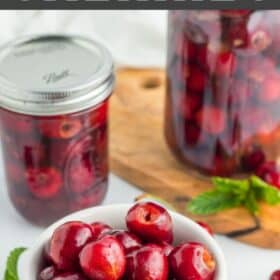
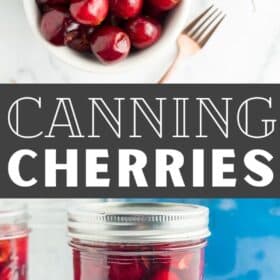
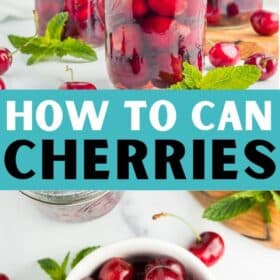
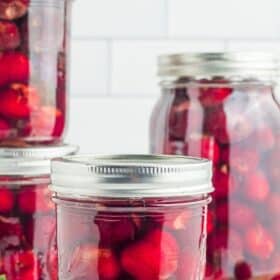

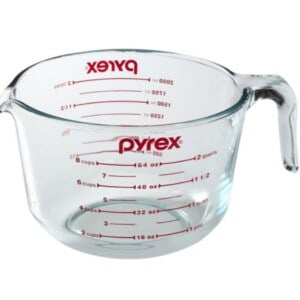
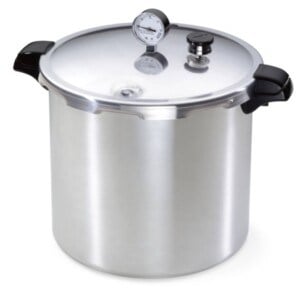
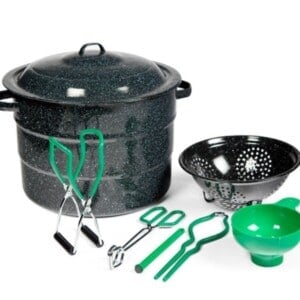
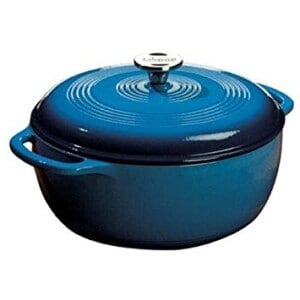
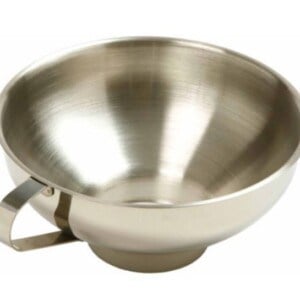
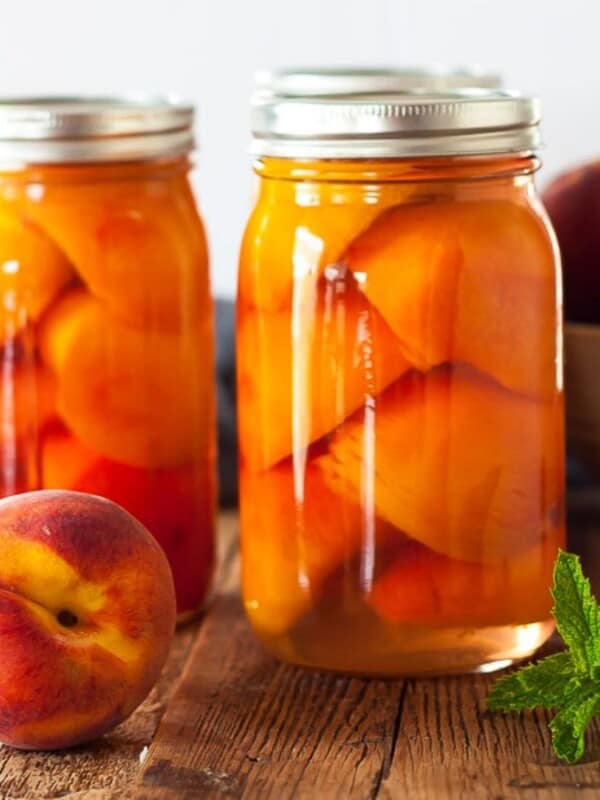
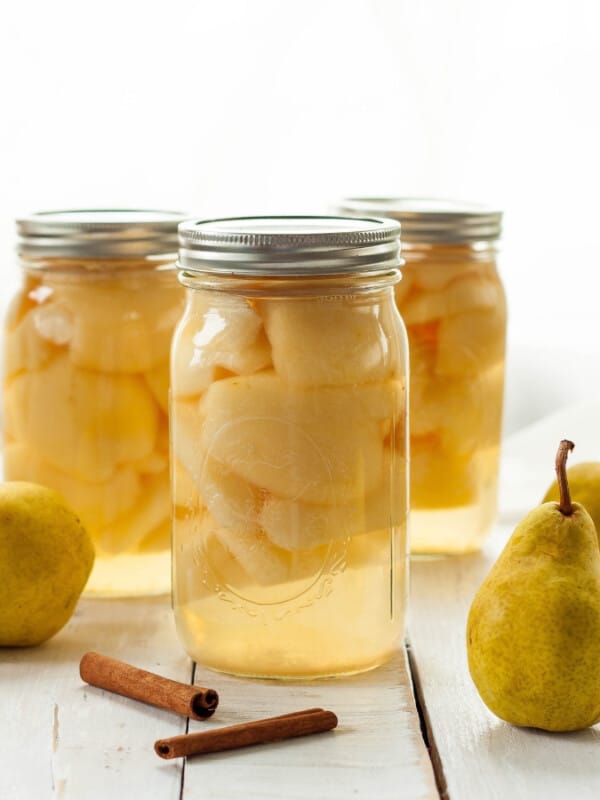
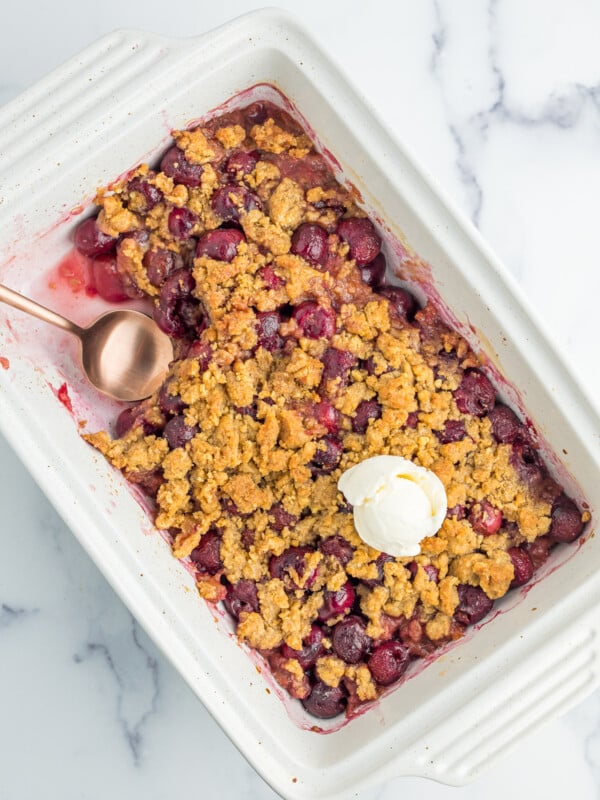
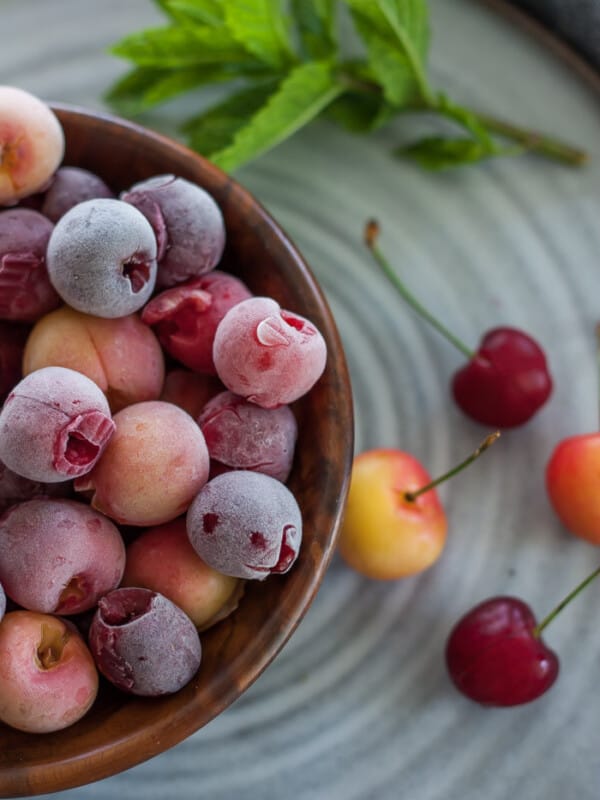
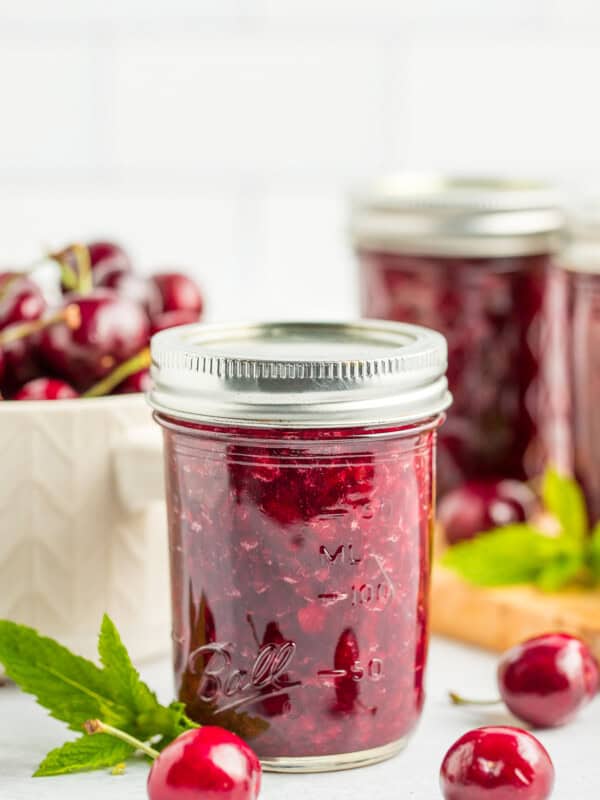
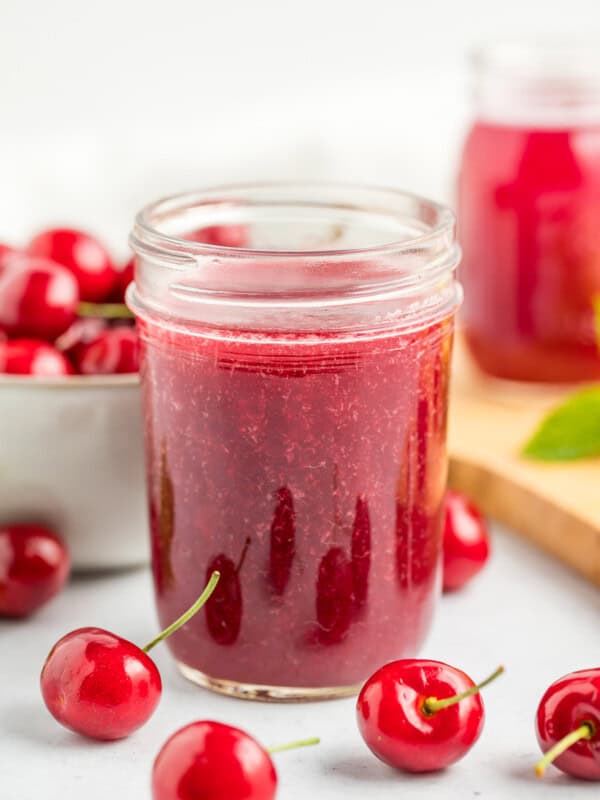






Gosh, this must have taken so long to put together. You are amazing! I’m considering canning, but it’s quite daunting. You have an induction cooktop now, right? Are you using a water canning pot on it? I think the one you linked is aluminum, and I have induction now (I’m a newbie with it also!).
Thanks!
Alicia
Every time I photograph a canning recipe, I think “this is a lot faster without taking pictures”. HA!
Yes, I have induction. For now, I’m using my dad’s gas stove in his downstairs apartment. But I just bought an electric water bath canner and an electric pressure canner to test for my readers. Presto (the brand of pressure canner I have) does make an induction canner that is $10 more than the one linked. You can find the induction one here: https://amzn.to/3rLeNFw
Even if you NEVER see yourself pressure canning, getting the induction pressure canner is a good investment. It can be used as a water bath canner and someday you might want to move to pressure canning.
They do make water bath induction canners for half the price (like this one), but looking at the photos, I’m not sure how in the world they can use it with water at a rolling boil 1-inch above quart jars. It just doesn’t look deep enough to me.
Thank you! Cherries were just 99 cents a pound, and Michigan peaches super cheap also. It makes me want to can them!